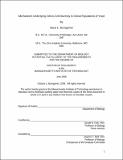Mechanisms underlying cell-to-cell diversity in clonal populations of yeast
Author(s)
Bumgarner, Stacie L
DownloadFull printable version (8.152Mb)
Other Contributors
Massachusetts Institute of Technology. Dept. of Biology.
Advisor
Gerald R. Fink.
Terms of use
Metadata
Show full item recordAbstract
The FLO promoters are among the largest promoters in yeast and receive a complex combination of signals from upstream signaling pathways through their association with downstream DNA binding factors and chromatin remodelers. The genes regulated by these promoters encode cell-surface glycoproteins that mediate a range of cell-to-cell and cell-to-surface adhesions. Phenotypic diversity in clonal populations of yeast cells is mediated in part by epigenetic silencing of the FLO10 and FLO11 promoters. Silencing of the FLO promoters is heterogeneous, or variegated, within a clonal population of cells. The variegated transcription of FLO10 and FLO11 results in a population of yeast cells that exhibits cell-to-cell variability in flocculation, adhesion to and invasion of inert surfaces, and filamentous growth. In this thesis, I discuss chromatin modifying proteins that localize to the FLO10 and FLO11 promoters and act in trans to affect transcription and silencing at these promoters. I describe the results of genome-wide screens to identify additional trans-acting chromatin modifying factors that play roles in the transcriptional regulation and silencing of the FLO10 and FLO11 promoters. Some of the candidates identified in these screens had effects on FLO transcription that initially seemed paradoxical in light of contemporary theories regarding the role of chromatin structure in regulating transcription. Given that histone deacetylases generally repress transcriptional activity, we were particularly surprised to find that mutations in components of the Rpd3L histone deacetylase complex reduce FLO promoter activity, indicating that Rpd3L plays a role in transcriptional activation of FLO genes. Careful analysis of these mutants, their phenotypes, the transcription of FLO11, and most importantly, the noncoding transcripts that we have detected in the promoter region of FLO11, have revealed the basis for this apparent paradox.
Description
Thesis (Ph. D.)--Massachusetts Institute of Technology, Dept. of Biology, 2008. This electronic version was submitted by the student author. The certified thesis is available in the Institute Archives and Special Collections. Includes bibliographical references.
Date issued
2008Department
Massachusetts Institute of Technology. Department of BiologyPublisher
Massachusetts Institute of Technology
Keywords
Biology.